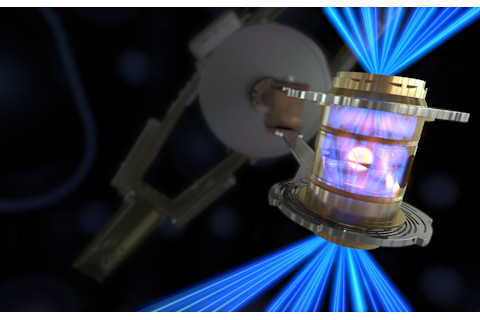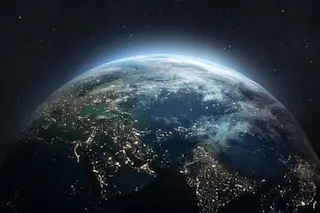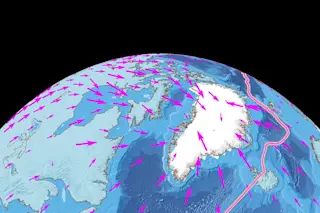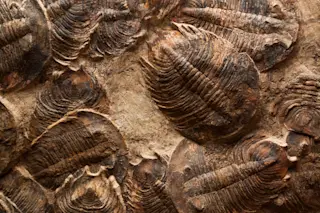On Dec. 13, 2022, the U.S. Department of Energy announced that scientists at the Lawrence Livermore National Laboratory’s National Ignition Facility (NIF) had made a major breakthrough in the pursuit of fusion energy. A team at NIF conducted the first controlled fusion experiment that produced more energy from fusion than the laser energy used to drive it, a condition known as ignition.
The team focused 2.05 megajoules of laser light onto a piece of fuel the size of a peppercorn. This resulted in an explosion producing 3.15 megajoules. That’s a small energy gain but a massive step in the field.

(Credit: Lawrence Livermore National Laboratory) The hohlraum that houses the type of cryogenic target used to achieve ignition on Dec. 5, 2022, at LLNL’s National Ignition Facility.
Lawrence Livermore National Laboratory
“This demonstrates it can be done,” U.S. Secretary of Energy Jennifer Granholm said at a press conference announcing the achievement. Granholm added that, with this threshold crossed, scientists can now start working on more efficient lasers, better containment and other details needed to take this to a commercial scale.

(Credit: Lawrence Livermore National Laboratory) To create fusion ignition, the National Ignition Facility’s laser energy is converted into X-rays inside the hohlraum, which then compress a fuel capsule until it implodes, creating a high temperature, high pressure plasma.
Lawrence Livermore National Laboratory
President Biden says he wants to see a commercial fusion reactor within a decade. Getting there is still a challenge, but today’s announcement makes it look far more realistic than ever.
While we celebrate these results and wait for more good news, here are ten things you need to know about nuclear fusion:
1. Is Nuclear Fusion Possible?
News reports about progress in fusion energy have been sporadic and often overblown, leading some to completely discount the potential of fusion energy. Yet scientists have been steadily progressing toward what is often called “the holy grail” of energy. As today’s announcement shows, they’re getting closer to that goal. There are some very real hurdles left, but fusion energy is not science fiction, nor is it some kind of futurist’s fantasy. It’s a real technology, and as we learned today, it’s achievable.
2. What Is Nuclear Fusion?
Nuclear fusion is a process where two small atomic nuclei merge to create a larger nucleus, which results in the release of significant energy. This process occurs in a state known as plasma, characterized by high temperatures that help overcome the repulsive forces between nuclei. The fusion reaction, which powers the sun and other stars, requires conditions of extreme temperatures and pressure to enable the nuclei to collide and combine.
Read More: How Do Stars Produce and Release Energy?
3. Who Discovered Nuclear Fusion?
The discovery of nuclear fusion gradually occurred over time, not all at once. It began to take shape in the 1920s when Arthur Eddington suggested stars fuse hydrogen into helium, influencing future astrophysics. Scientists like Atkinson and Houtermans further explored star fusion rates, while Ernest Rutherford and his student Mark Oliphant demonstrated fusion in the lab in 1934. Hans Bethe later explained this process in stars, paving the way for fusion reactor development in the 1950s.
4. Where Does Nuclear Fusion Occur in the Sun?
Nuclear fusion happens in the core of the Sun. This is where tiny particles called protons come together to form helium, a process that produces the Sun's heat and light. Almost all of the Sun's energy comes from this fusion happening in its core, and this energy then spreads out into the solar system.
Read More: Determining Nuclear Fusion's Future
5. Is Nuclear Fusion Safe?
Unlike nuclear fission, the process that powers today’s nuclear power plants, fusion energy poses no risk of out-of-control chain reactions and meltdowns, like the disaster in Chernobyl in 1986. Fusion also produces far less radioactivity and hazardous waste and does not produce greenhouse gasses. The primary by-product of fusion is helium — an inert, non-toxic gas.
6. How Does Nuclear Fusion Work?
The science of fusion energy is far from simple but well understood. What makes fusion energy so elusive are the difficulties in engineering a device that can produce it. Making a fusion reactor is like creating — and containing — a tiny star on Earth. To achieve conditions where fusion energy will be created, scientists generate extremely hot plasmas — ionized gasses. At these temperatures, ions that would normally be repelled from each other smash into one another and fuse. When this happens, energy is released. Scientists control the monstrously hot plasma by means of lasers or magnetic fields. It’s a complex and massive engineering feat.
Read More: Why Nuclear Fusion Is Always 30 Years Away
7. What Are the Benefits of Nuclear Energy?
Energy from nuclear fusion would be safe, clean, carbon-free and almost limitless. It’s hard to overstate how much this would impact every aspect of life on Earth. If everyone seems pretty excited about these advances, that’s why.
8. What Is the Difference Between Nuclear Fission and Nuclear Fusion?
The difference between nuclear fission and nuclear fusion is that nuclear fission splits heavy atoms into smaller ones, while nuclear fusion combines light atoms to form heavier ones. Both processes release energy because the new nucleus is lighter than the sum of the original atoms.
Read More: 5 Times Radioactive Items Went Missing
9. Does Nuclear Fusion Produce Radioactive Waste?
Nuclear fusion, unlike nuclear fission, doesn't create dangerous, long-lasting radioactive waste. What it does produce is helium, which is harmless, and a little bit of tritium, which is slightly radioactive but safe in small amounts and doesn't last long. The only concern is that parts of the fusion reactor can become a bit radioactive over time because of all the neutrons flying around, but scientists are working on ways to make this less of a problem.
10. When Will Nuclear Fusion Be Viable?
This is indeed a huge step, but we’re not there yet. To be commercially viable, a fusion plant would have to produce in one-tenth of a second the amount of energy produced in one day at NIF. What these latest results tell us is that it can be done. Investments of time, money, and expertise can pay off in a big way.
“The National Academy last year said we should aim for first fusion electricity between 2035 and 2040. I think that is hard but a worthy target," says Steven Cowley, director of the Princeton Plasma Physics Laboratory.
Although it won’t happen tomorrow, a future powered by safe, clean fusion energy looks much closer today than it did yesterday.
Read More: What Is Cold Fusion? Is It Possible?
This article was originally published on Dec. 13, 2022 and has since been updated by the Discover staff.











